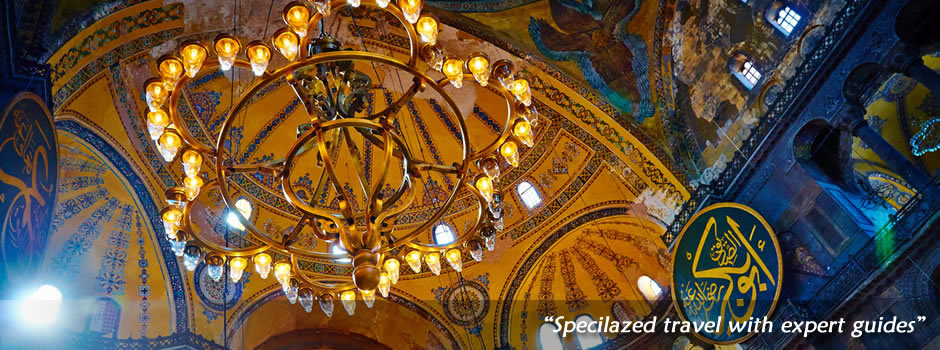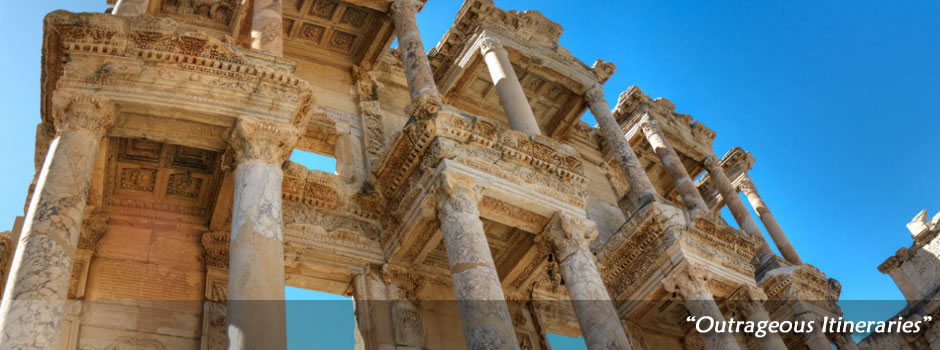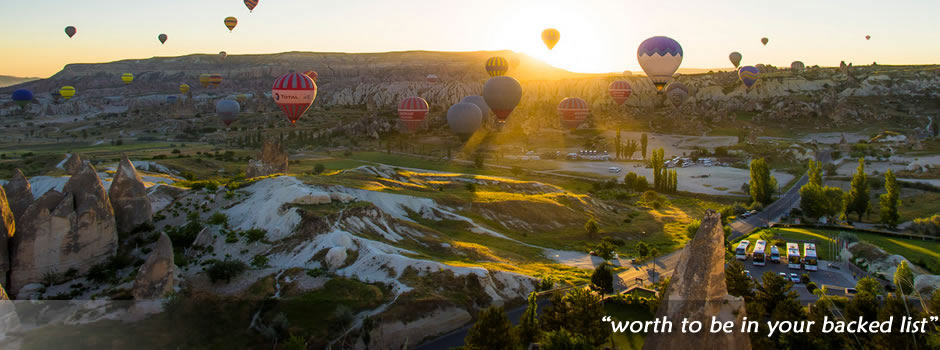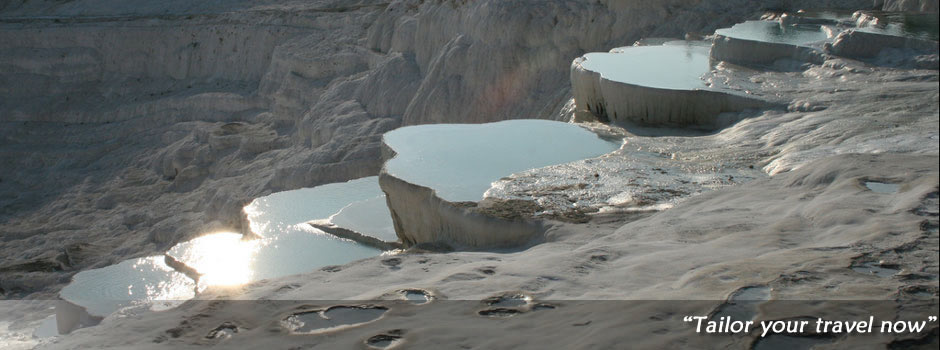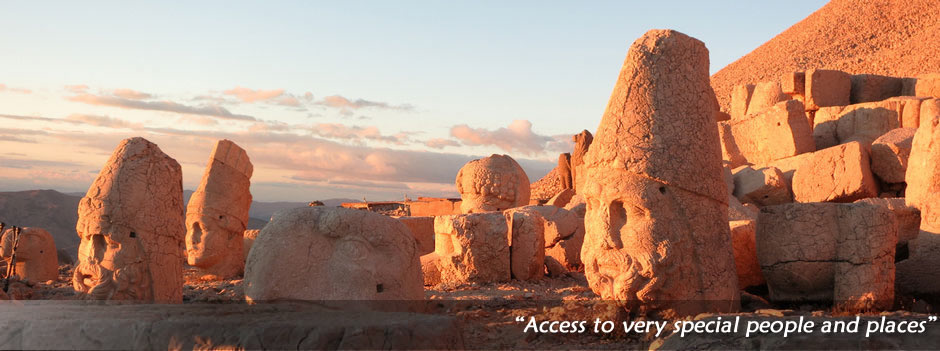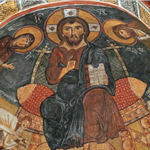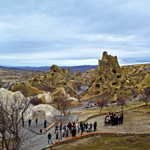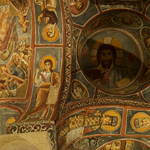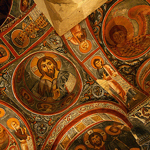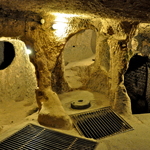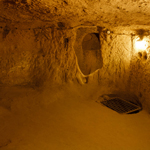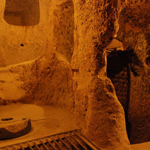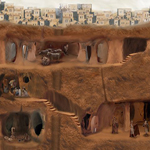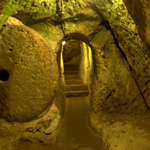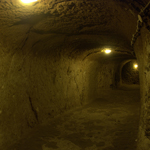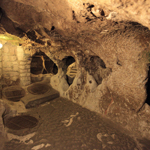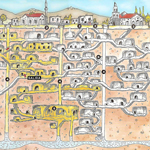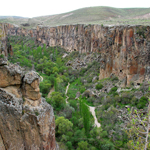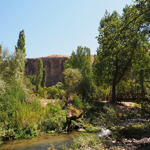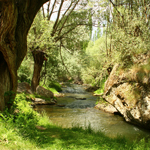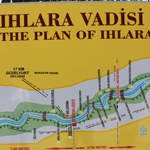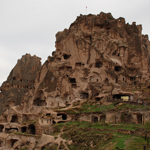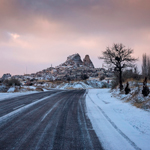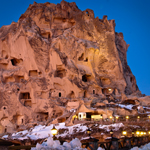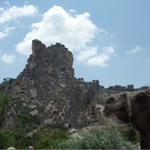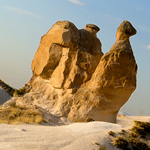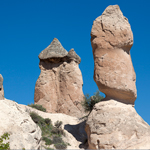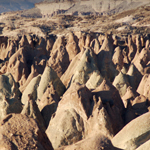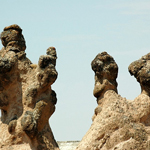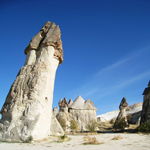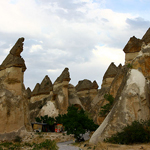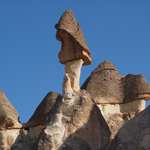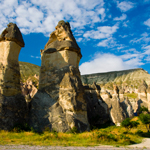ABOUT CAPPADOCIA
ATTRACTIONS OF CAPPADOCIA
Cappadocia is the name of the large region in the central of Anatolia covers five cities of Turkey or more specifically a smaller triangular area Urgup to Avanos and to Nevsehir. The strange but beautiful formation of Cappadocia has had this appearance for millions of years. When the volcanoes in the region were active, the lava which poured out covered all previously formed hills and valleys forming a high plateau. this newly formed plateau consısts mainly of tufa and some rare layers of basalt. The destruction of the tufa and the basalt layers by erosion (heavy rains and melting snow in spring) and sharp temperature changes has continued for thousands of years and is still in process today. The basalt is less affected by erosion when compared to the tufa and has served as a protective cover. These rock formations called fairy chimneys. There are also lots of rock cut churches in Cappadocia. Walls of these churches were covered with beautiful frescoes date from the 11C and 12C. Most beautiful examples of the churches in Göreme Open Air Museum.
The most beautiful places worth to see in Cappadocia:
-Göreme Open Air Museum
-Kaymakli Underground City
-Derinkuyu Underground City
-Ihlara Valley
-Uchisar Castle
-Devrent Valley (Imagination Valley)
-Pasabag Valley
Göreme Open Air Museum
Cappadocia’s most famous attraction, for good reason, is the Göreme Open Air Museum, a complex of medieval painted cave churches carved out by Orthodox monks.In the 4th century, Cappadocia became known as the “Land of the Three Saints” because of three remarkable theologians who are still collectively known as The Cappadocians: St. Basil the Great, his brother St. Gregory of Nyssa, and St. Gregory of Nazianzus contributed a great deal to Christian doctrine in general and Eastern Orthodox thought in particular. St. Basil was instrumental in developing Christian monasticism, of which these cave churches in his homeland are a product. The monastic complex at Göreme was carved out and decorated between 900 and 1200. There are over 10 cave churches in the Göreme Open Air Museum. Along with rectories, dwellings, and a religious school, they form a large monastic complex carved out of a roughly ring-shaped rock formation in the otherworldy landscape of Cappadocia.
St. Basil’s Church (St. Basil kilisesi )
St. Basil’s Church has a rectangular nave with niches and three apses, separated from a narthex by arches. The narthex has tombs in the floor, which are open but covered with metal grating. Fresco subjects in this church include Christ, St. George, St. Basil and St. Theodore. The three Maltese crosses on the vault of the nave are believed to represent the Holy Trinity.
Apple Church ( Elmalı kilise )
The frescoes of the Apple Church mostly date from the 11th century. The interesting name probably derives from a red orb held by St. Michael the Archangel in a fresco near the entrance, but an alternative theory is that an apple tree used to grow next to it. The frescoes depict saints and bishops, with a Last Supper including a large fish to the right of the altar.
St. Barbara Chapel
This cruciform chapel with three apses is mostly decorated with simple figures and symbols in red paint on white plaster, making a sharp contrast with the colorful figures of most Göreme frescoes. They may have been painted shortly after the 8th-century iconoclastic controversy. A giant locust symbolizing evil on one wall opposes two crosses on the other, while a rooster representing the devil is battled with bricks representing the Church. Other strange creatures and shapes are more difficult to interpret. The figurative frescoes include Christ Pantocrator, St. George and the Dragon, St Theodore, and St Barbara.
Snake Church ( Yılanlı kilise )
The Snake Church has a long nave with a low, barrel-vaulted ceiling. Among the frescoes are portraits of St. Theodore, St. George slaying the dragon again (it looks like a snake, for which the chapel is named), Emperor Constantine and his mother St. Helena, and St. Onuphrius. The last saint was an Egyptian hermit who lived near Thebes. In medieval art, including in this example, he is usually depicted with a long gray beard, wearing nothing but a fig leaf.
Dark Church ( Karanlık kilise )
The Dark Church, so named for the little light that penetrates the interior, was used as a pigeon house until the 1950s. It took 14 years to scrape pigeon poo off the walls, but underneath were beautifully preserved 11th-century frescoes. Recently restored, the paintings of New Testament scenes and other subjects are considered the best-preserved frescoes in Cappadocia.
Sandal Church ( Carıklı kilise )
This church is named for two footprints just inside the entrance, around which many legends have been woven. Suggestively, a fresco of the Ascension can be seen directly of above. The narthex of the church has collapsed; the nave has a cross plan with barrel vaults and 11th-century frescoes. The fresco subjects are New Testament scenes such as the Nativity, Adoration of the Magi, and the Baptism of Christ. The main cupola has a Christ Pantocrator with the Four Evangelists below; the other three cupolas are occupied by the angels Michael, Gabriel and Uriel.
In the apse is a Deesis (Christ with Mary and John the Baptist), with an inscription next to Christ reading “I am the light of the world, who follows me will not be left in the dark.” Around the altar are saints: Blaise, Gregory of Nazianzus, Basil, Chrysostom and Hypatius.
Nunnery
The last sight within the museum complex near the exit is a remarkable rock-carved convent with six stories of tunnels, corridors, stairways and chambers. It housed as many as 300 nuns at any one time.
Buckle Church (Tokali Kilise)
Just outside the museum exit on the right is the Buckle Church, the largest of the cave churches at Göreme. It can be entered with the same ticket as the main complex and should not be missed. The frescoes are also the finest in Göreme, with the richest colors and the most detail. It dates from the 10th and 11th centuries and was restored in the 1960s. The Buckle Church is comprised of four chambers, which are known as the Old Church, New Church, Paracclesion and Lower Church. The Old Church (10th century) has a single nave with a barrel vault. The frescoes give a comprehensive account of the life of Christ, from the Annunciation through the Baptism and Miracles and ending with the Passion, Resurrection and Ascension. The Transfiguration is painted over the entrance and the vault has portraits of saints.
The Old Church now acts as a narthex for the New Church, which was added to the former’s east side around 990-1010 AD. Its barrel-vaulted nave tells the story of Christ in deep red and blue hues.
Kaymakli Underground City
Ancient name was Enegup. Kaymakli people were built their homes around the underground city tunnels for security reason. Kaymakli underground city has 8 storey and 5000 peoples can live in it, 4 storey is open yet. The deepest point of the visit is under 20 meters. Kaymakli was built in around a main ventilation chimney. Ventilation system is so successful that not feel a problem even the fourth floor. Has all housing conditions for crowdy group temporary housing. There are rooms and halls connecting to each other with narrow corridor, wine tanks, water cistern, kitchen and food stores, ventilation chimneys, water wells, churches and large lock stones for any danger from out. Kaymaklı Underground City is part of a UNESCO World Heritage site since 1985.
Derinkuyu Underground City
The underground city of Derinkuyu which means "deep well", like Kaymakli, is one of the largest. It was opened in 1965. It is 70-85 m / 230-300 ft deep with 53 airshafts. The original ventilation system still functions remarkably well. It is not recommended that visitors having problems of claustrophobia or restricted movement go inside since there are many passageways where one has to squat. The first two floors under the surface housed a missionary school with two long rock-cut tables, baptismal place, kitchens, storehouses, living quarters, wine cellars and stables. Third and fourth floors were for the tunnels, places to hide and armories. The last floors had water wells, hidden passageways, a church and graves.
Ihlara Valley
Ihlara valley is a deep, narrow river gorge cut through the tufa by Melendiz River. The river running through the Ihlara valley at its lowest level is still contributing to the erosion of it. The valley runs for 20 km offering one of the most enjoyable trekking routes to the visitors. In the valley there are about 60 churches, monasteries and cells of anchorites. What makes the valley unique is the ancient history of its inhabitants.
Due the valley's plentiful supply of water and hidden places, here was the first settlement of the first Christians escaping from Roman soldiers. In the Ihlara Valley there are hundreds of old churches in the volcanic rock caves. The most known churches are Ağaçaltı Church with cross plan, Sümbüllü Church, Pürenliseki Church, Kokar Church, Yilanli Church, Karagedik Church, Kirkdamatli Church, Direkli Church, Ala Church, Kemerli Church and Egritas Church.
Uchisar Castle
The view from the top of this extraordinary rock, with its height of 1350 meters above sea level is unforgettable as it offers a panoramic view of all of Cappadocia, including the magnificent Mount Erciyes.
It is obvious from this location that Uçhisar was once an important strategic point. From the 5th century on during the Byzantine Period, this place was used as natural fortress for defense against Persian invaders. As time went on, more and more caves were hollowed out of the soft tuff as the people sought refuge here. In the rock-hewn churches they prayed for their lives. The gates, entrances and pathways of the kale were doubly and triply secured by heavy, round stones, which were rolled in front of the openings. These blocks had been cut directly out of the wall, and once closed from the inside, there was no chance for the intruders to force their way into the rooms (link underground cities). Despite all precautions, however, the kale would ultimately fall to the enemy, proving that even the strongest defense may in time prove vulnerable. The first changes
After the Byzantine Empire began to decline in Anatolia it was summarily defeated by the Turkish Seljuks in the 11th century. The kale then fell into the hands of the Seljuks who proved to be enlightened rulers. Photo: Fairy Chimney in Cappadocia, TurkeyThe villagers stayed in their homes and accepted the new dynasty. Again, more houses were erected in front of the dwellings in the rock. Uçhisar continued to remain intact under later principalities and also under the rule of the far flung and powerful Ottoman Empire.
Devrent Valley (Imagination Valley)
This is a place to let your mind run free in a seemingly lunar landscape with rock formations that look like animals. The Devrent Valley, also known as Imagination Valley, has none of the cave churches, Byzantine frescoes or Roman citadel ruins that are famous throughout the rest of Cappadocia; but what it does have is an extraordinary landscape shaped by nature to make you laugh and wonder and explore. Between Avanos and Ürgüp, the valley is like a rock-formed zoo. Walk the trail and you’ll see a landscape filled with snakes, camels, seals and dolphins and whatever else your mind chooses to make of the twisting curving rocks. Maybe even a dragon. There are also small fairy chimneys, the rock pillars so distinctive of Cappadocia.
Pasabag Valley
Formerly known as “Monks Valley”, Paşabağ is situated about 1 km from the Göreme-Avanos road. Many fairy chimneys with multiple sems and caps can be found here, this style being unique to this area. A chapel dedicated to St. Simeon, and a hermit’s shelter is built into one such fairy chimney with three heads.
St. Simeon was living in seclusion near Aleppo in the 5th century, when rumours that he worked miracles started to spread. Disturbed by all the attention, he began to live at the top of a 2m high column, and later moved to one 15m in height. From there he only descended occasionally to get the food and drink brought by his disciples.
The hermits of Cappadocia distanced themselves from the world by cutting into fairy chimneys rather than living on top of columns. They hollowed out the chimneys from top to the bottom creating rooms 10-15m high. They lay on beds made from rock.




![]() As featured in Romantic
As featured in Romantic 